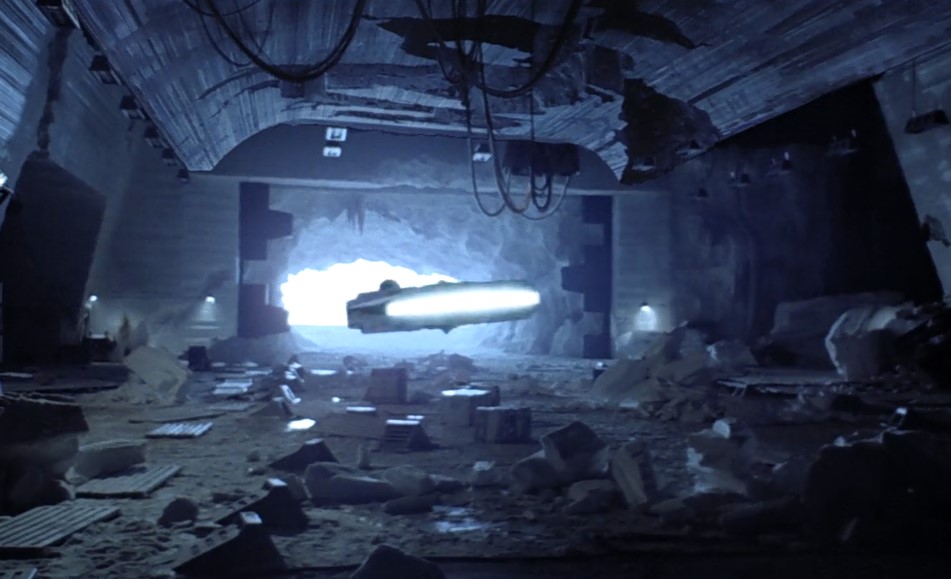By Lt. Col. Jim Davitch
Darth Vader looked on as the Millennium Falcon, engines screaming to life, darted from the ice planet Hoth and into the freedom of space. The getaway was short-lived. C-3PO implored anyone to listen as he tried to explain that the hyperdrive was damaged, and consequently the Rebel ship would not be able to achieve light speed and escape the Empire’s ambush. Han Solo tried to engage the horizontal boosters, the alluvial dampers, the hydrospanners… nothing worked. Han concluded, dejectedly, “We’re in trouble.” Solo had a choice to make – and it was at this point in Star Wars: Episode V – The Empire Strikes Back that his process of deciding what to do next becomes interesting to observe in the context of contemporary decision making theory.
The Evolution of Decision Theory

In the 1950s, mathematicians working for the Department of Defense and assigned to the RAND Corporation studied decision making, mainly as it pertained to nuclear weapons development, doctrine, and employment. One of the scientific luminaries at the time was a genius of Hungarian lineage named John Von Neumann, who some say was partially the model for Stanley Kubrick’s Dr. Strangelove. He and an equally distinguished researcher named Oskar Morgenstern expanded on an existing idea of decision making called “Expected Utility Theory.” Their thoughts about rational decision making held sway for decades and influenced scores of international relations scholars. According to their model, rational humans attempt to maximize utility when making decisions, with “utility” roughly translating to “benefits” or “value” and often expressed numerically. At a glance, the theory makes sense. Why would someone choose to do otherwise? Why would one deliberately select an option that results in a losses or a less optimal outcome?

It wasn’t until the 1970s that the psychologists and behavioral economists Daniel Kahneman and Amos Tversky provided an answer. It wasn’t that people deliberately choose bad options with the knowledge they’d end up in a worse situation. It was that people routinely made bad decisions because of factors called heuristics which are like mental shortcuts. After testing their ideas in realistic settings Kahneman & Tversky created a theory of decision making now known as “Prospect Theory.”
Prospect theory provided a novel way of predicting how individuals might make decisions and it accounted for things that expected utility theory did not, such as an irrational decision maker. Prospect theory identified that irrationality might be influenced by how a decision maker approaches risk, and that one’s approach might depend on the situation at hand. If things are going well, people tend to be risk adverse. If the decision maker is in the midst of a situation going poorly, like a losing battle aboard a spaceship with no hyperdrive, then they tend to be riskier.
Prospect theory also identified that one’s understanding of value depends on having a definite reference point, rather than the utility of that value. To clarify, imagine you have $1 million and your Bothan friend has $10 million. These are the reference points. Tomorrow you wake up and you each have $5 million. Utility theory would say that you both have the same value. But clearly your Bothan brother would probably consider himself in worse shape than you – your reference points are different. Kahneman & Tversky summarized this within prospect theory by saying we dislike losses more than we value gains.
This conclusion, from a military perspective, was illuminating and found many applications from deterrence theory to coercive bargaining. It meant that in crisis decision making, an adversary might be more willing to take chances to prevent losses than to take chances to that might result in gains. That, in turn, potentially provides one a slight window into an opponent’s decision process, a peak at what the enemy might do next. It could allow someone to do as the Air Force fighter pilot-turned theoretician John Boyd would have recommended – to get inside an opponent’s decision making loop.
Kahneman & Tversky found something else in their studies of human decision making. Through multiple, repeatable experiments they concluded that humans are not good at understanding probabilities. They weren’t just pointing to normal everyday people, but professionals with a background in statistical reasoning. In short they found that we are all poor statisticians, regardless of how fast you might have made the Kessel Run. Moreover, instead of referencing things like sample size before making a judgement, people routinely instead trusted their intuitive judgement. The pilot of the Millennium Falcon will demonstrate this concept in just a few paragraphs.
The political scientist Philip Tetlock also demonstrated how poorly we understand statistics in his research on predicative analysis. Tetlock writes in his book Superforecasting how the human mind’s desire for order is in tension with probabilistic reasoning. Thinking in terms of chance, as opposed to fate, creates cognitive distress and prevents us from assuming we live in an ordered universe. From a storytelling perspective, it’s much more palatable to presume that the Empire is fated to lose than to consider the probability that the odds might be ominously against the chances of the Rebels winning.
Lies, Damn Lies, and Asteroids
Returning to the escape from Hoth, the crew of the Millennium Falcon was soon to face a choice. Should they attempt, futilely, to outrun the enemy Star Destroyers and most likely live but end up in the custody of the Empire? Or should they try to lose their pursuers amidst the asteroids. Leia attempts to reason with Han:
LEIA
What are you doing? You're not actually going into an asteroid field?
HAN
They'd be crazy to follow us, wouldn't they?
The odds of surviving capture and, at a minimum, imprisonment by the Empire? So so. The odds of surviving a jaunt through an asteroid field? Well, C-3PO describes it nicely:
THREEPIO
Sir, the possibility of successfully navigating an asteroid field is approximately three thousand, seven hundred and twenty to one.
Han replies with the famous line:
HAN
Never tell me the odds!

Solo simultaneously asserts his dominance while also rejecting statistical reality (and, one might argue, demonstrating the limits of artificial intelligence (C-3PO) as an augmentation to human decision making. But that’s a different discussion for another time…). In so doing he confirms what Kahneman, Tversky, Tetlock, et al. have argued about how we lack the mental tools to deal with probabilities.
Han Solo’s gamble pays off as he employs a technique one might call the “I-don’t-need-your-book-learnin’” trope whereby the hero rejects thoughtful, reasoned analysis as less honorable than going with his/her gut. Just a few short scenes later in “Empire” we see nearly the same situation play out, with nearly the same decision making process. Witness…
THREEPIO
Sir, we just lost the main rear deflector shield. One more direct hit on the back quarter and we're done for.
Han pauses for a moment, makes a decision, and pulls back on a lever.
HAN
Turn her around.
Chewie barks in puzzlement.
HAN
I said turn her around! I'm going to put all power in the front shield.
LEIA
You're going to attack them?!
THREEPIO
Sir, the odds of surviving a direct assault on an Imperial Star Destroyer...
LEIA
Shut up!
Now Leia, a convert to the idea that mathematical analysis does not matter in high risk decision making, becomes an accomplice in Solo’s seemingly irrational cognitive process. But pressure situations cause the lowly Rebels to make all kinds of poor decisions, as I’ve previously noted in these pages here. Han Solo proceeds into the asteroid field and later charges toward a Star Destroyer with reckless disregard for he and his crew’s expected utility but in perfect accordance with prospect theory. Kahneman & Tversky would approve.
Recall, however, the same Han Solo at the conclusion of the previous Star Wars film, Episode IV: A New Hope. Solo, fresh off the escape from the Death Star and the return of Princess Leia to the Rebel Alliance, is rewarded handsomely for his efforts. His immediate pressure is low and he and Chewbacca are faring well. With cases full of cash they set out to repay the bounty on Solo’s head, at which point, presumably, they’ll be free to do as they wish for the remainder of their lives. This is no time to accept unnecessary risks and so the Falcon departs from the Rebels. We must assume that somewhere on the road to Tattoine the thought of having abandoned his friends changed Solo’s reference point – and what initially appeared as a gain (leaving with the money) was actually a loss. Thus, the Falcon’s surprise return to assist Luke Skywalker provides the fitting exception that proves the general rule that, in Star Wars and in Earth’s wars, prospect theory can explain a lot.
Enjoy what you just read? Please share on social media or email utilizing the buttons below.
About the Author: Lt Col Jim Davitch is an Air Force officer. He’s written for Joint Force Quarterly, Strategy Bridge, the Air & Space Power Journal, Over the Horizons Journal, and the Angry Staff Officer. The staff of NDU Press chose his essay on open source intelligence for the Maerz Award as one of the most influential Joint Force Quarterly articles in 2018. His wife was overheard remarking, “Oh that’s nice, honey.” He is available on Twitter, @jimdavitch12.
The opinions reflected here are those of the writer and the Editor’s alone and do not represent those of the United States Air Force or the Department of Defense.
About the Editor: Angry Staff Officer is an Army engineer officer who is adrift in a sea of doctrine and staff operations and uses writing as a means to retain his sanity. He also collaborates on a podcast with Adin Dobkin entitled War Stories, which examines key moments in the history of warfare. Support this blog’s Patreon here.




2 Replies to “Never Tell Me the Odds: Prospect Theory, Risk Acceptance and Asteroid Fields”
Comments are closed.